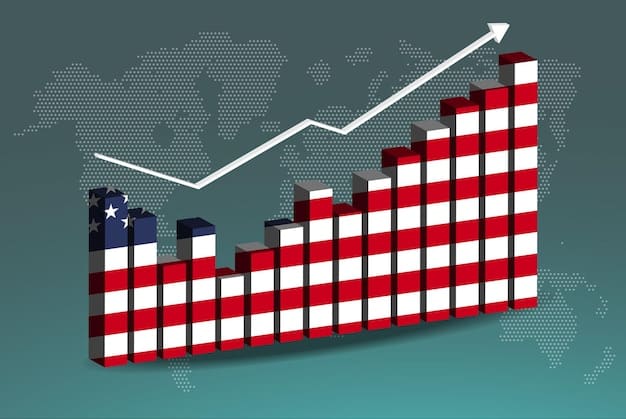The Impact of 3% Inflation on US Household Expenses

The Impact of the 3% Inflation Increase on Everyday Expenses for US Households manifests as higher costs for groceries, transportation, housing, and healthcare, potentially straining household budgets and requiring adjustments in spending habits.
The US economy has been under scrutiny with fluctuating inflation rates, directly impacting the cost of living for households nationwide. A 3% increase in inflation, while seemingly small, can significantly affect everyday expenses, altering how families manage their budgets and make financial decisions. Understanding the impact of the 3% inflation increase on everyday expenses for US households is crucial for navigating the current economic landscape.
Understanding Inflation and Its Measurement
Inflation is the rate at which the general level of prices for goods and services is rising, and subsequently, purchasing power is falling. It’s a key economic indicator that influences everything from interest rates to consumer behavior. Understanding how inflation is measured is essential to grasping its true impact.
Consumer Price Index (CPI)
The Consumer Price Index (CPI) is the most widely used measure of inflation. It tracks the average change over time in the prices paid by urban consumers for a basket of goods and services, including food, housing, transportation, medical care, recreation, education, and communication.
Personal Consumption Expenditures (PCE)
The Personal Consumption Expenditures (PCE) price index is another measure of inflation, preferred by the Federal Reserve. PCE tracks the change in prices of goods and services purchased by consumers in the United States. It is considered more comprehensive than CPI because it accounts for changes in consumer behavior and uses a different weighting system.

Both CPI and PCE provide valuable insights into inflation. While CPI is often cited in the news, PCE is closely monitored by economists and policymakers due to its broader scope and ability to reflect shifts in consumer spending patterns.
- CPI measures the change in prices paid by urban consumers for a fixed basket of goods and services.
- PCE tracks the change in prices of goods and services purchased by consumers, accounting for shifts in behavior.
- The Federal Reserve uses PCE as its primary measure of inflation when making monetary policy decisions.
In conclusion, understanding how inflation is measured through CPI and PCE is crucial for assessing its real impact on the economy and household finances. These measures help policymakers and consumers make informed decisions in the face of rising prices.
The Direct Impact on Household Budgets
A 3% inflation increase directly influences the disposable income and financial stability of households. It alters the amount of purchasing power families have, impacting their spending habits and savings.
When inflation rises, the cost of essential goods and services, such as groceries, rent, healthcare, and transportation, increases. This means that households need to allocate more of their budget to cover these basic needs, leaving less money for discretionary spending, savings, or investments.
Lower-income households are disproportionately affected by inflation, as a larger portion of their income is spent on essential goods. Even a small increase in prices can significantly strain their already tight budgets, leading to difficult trade-offs between necessities.
Furthermore, inflation can erode the real value of savings. If the inflation rate is higher than the interest rate earned on savings accounts or investments, the purchasing power of those savings decreases over time. This can impact long-term financial goals, such as retirement planning or funding education.

In response to inflation, families may need to make adjustments to their budgets, such as cutting back on non-essential spending, finding ways to save on everyday expenses, or seeking additional income sources. Understanding these direct impacts on household budgets is critical for navigating inflationary periods and making informed financial decisions.
Effects on Specific Expense Categories
The impact of a 3% inflation increase is not uniform across all expense categories. Some areas of household spending are more sensitive to price changes than others. Understanding these specific effects can help families prioritize their budget adjustments.
Food and Groceries
Food prices are highly susceptible to inflation. A 3% increase can significantly impact grocery bills, especially for families with children. The cost of staples like bread, milk, eggs, and meat can rise noticeably, requiring households to seek out discounts, buy in bulk, or switch to cheaper alternatives.
Housing and Rent
Housing costs, including rent and mortgage payments, are a major expense for most households. While mortgage payments may remain fixed for those with fixed-rate mortgages, property taxes and insurance costs can increase with inflation, leading to higher monthly expenses. Rent prices often rise with inflation, making it more challenging for renters to find affordable housing.
Transportation
Transportation costs, including fuel, car maintenance, and public transportation fares, are also sensitive to inflation. Rising fuel prices directly impact the cost of commuting and running errands. Car maintenance and repair costs may also increase as the prices of parts and labor rise.
Healthcare and Insurance
Healthcare costs typically outpace the general inflation rate. A 3% inflation increase can exacerbate the already high costs of medical care, prescription drugs, and health insurance premiums. This can lead to families delaying or forgoing necessary medical treatments or reducing their insurance coverage.
- Food and grocery prices can increase significantly, impacting household food budgets.
- Housing and rent costs may rise, making it harder for families to afford shelter.
- Transportation expenses, including fuel and maintenance, are directly affected by inflation.
In conclusion, the effects on specific expense categories vary, but the common thread is increased financial strain on households. Addressing these impacts requires careful budgeting, prioritization, and exploration of cost-saving strategies.
Strategies for Mitigating the Effects of Inflation
While inflation can be challenging, there are strategies that households can employ to mitigate its effects. These strategies involve careful budgeting, smart spending habits, and proactive financial planning.
Creating a budget is the first step in managing expenses during inflationary periods. This involves tracking income and expenses to identify areas where spending can be reduced. Prioritizing essential needs over discretionary wants can help families stay within their budget.
Smart spending habits can also help mitigate the effects of inflation. This includes seeking out discounts, using coupons, buying in bulk, and comparing prices before making purchases. Switching to generic brands or cheaper alternatives can also save money on groceries and household items.
Negotiating Bills and Services
Negotiating bills and services can also help reduce expenses. This includes contacting service providers, such as cable, internet, and insurance companies, to negotiate lower rates or switch to cheaper plans. Shopping around for better deals can lead to significant savings.
Investing in Inflation-Resistant Assets
Investing in inflation-resistant assets can help protect savings from the eroding effects of inflation. This includes investing in Treasury Inflation-Protected Securities (TIPS), real estate, or commodities, which tend to hold their value during inflationary periods. Consulting with a financial advisor can help determine the best investment strategy.
Adopting these strategies can help families navigate inflationary periods, protect their financial well-being, and maintain their standard of living.
Government Policies and Inflation Control
Government policies play a crucial role in controlling inflation and stabilizing the economy. Central banks, such as the Federal Reserve, use various tools to manage inflation and keep prices stable.
Monetary policy is the primary tool used to control inflation. The Federal Reserve can raise or lower interest rates to influence borrowing costs and economic activity. Raising interest rates can help cool down the economy, reduce demand, and curb inflation.
Fiscal policy, which involves government spending and taxation, can also impact inflation. Government spending can stimulate demand and potentially lead to inflation, while taxation can reduce disposable income and curb demand. Balancing fiscal policy is essential for maintaining stable prices.
Supply-Side Policies
Supply-side policies, such as deregulation and investment in infrastructure, can also help control inflation by increasing the supply of goods and services. This can help meet demand and prevent prices from rising excessively.
Wage and Price Controls
Wage and price controls are another tool that governments can use to control inflation. These controls involve setting limits on wages and prices to prevent them from rising too quickly. However, these controls can distort markets and lead to shortages, so they are often used as a last resort.
- Monetary policy, managed by central banks, influences borrowing costs and economic activity to control inflation.
- Fiscal policy, involving government spending and taxation, can impact demand and prices.
- Supply-side policies aim to increase the supply of goods and services to meet demand and prevent inflation.
Effective government policies are essential for maintaining price stability, promoting economic growth, and protecting the financial well-being of households.
Long-Term Financial Planning in an Inflationary Environment
Long-term financial planning becomes even more critical in an inflationary environment. Rising prices can erode the value of savings and investments, making it essential to plan for the future and protect one’s financial security.
Retirement planning should take into account the impact of inflation on future expenses. Estimating future living costs and adjusting savings goals accordingly can help ensure a comfortable retirement. Consider investing in assets that tend to outpace inflation, such as stocks or real estate.
Education Savings
Education savings plans, such as 529 plans, should also account for the increasing cost of tuition and other education-related expenses. Saving early and investing wisely can help families afford the rising costs of higher education.
Inflation can impact debt management strategies. High-interest debt, such as credit card debt, can become more burdensome during inflationary periods. Prioritizing debt repayment and consolidating debt at lower interest rates can help reduce financial strain.
Protecting one’s financial security in an inflationary environment requires proactive planning, diligent savings, and informed investment decisions. Consulting with a financial advisor can provide personalized guidance and help individuals achieve their long-term financial goals.
| Key Point | Brief Description |
|---|---|
| 📈 Increased Living Costs | Groceries, housing, and transportation become more expensive. |
| 💡 Budget Adjustments | Households need to cut back on non-essentials. |
| 💰 Savings Erosion | Inflation reduces the purchasing power of savings. |
| 🏦 Government Policies | Central banks use monetary policy to control inflation. |
Frequently Asked Questions (FAQ)
▼
Inflation is the rate at which the general level of prices for goods and services rises. It is commonly measured by the Consumer Price Index (CPI) and the Personal Consumption Expenditures (PCE) price index.
▼
A 3% inflation increase raises the cost of essential goods and services, such as groceries, housing, and transportation, reducing disposable income and affecting spending habits.
▼
Households can mitigate inflation by creating a budget, seeking discounts and coupons, negotiating bills, and investing in inflation-resistant assets like TIPS or real estate.
▼
Government policies, such as monetary policy (managed by central banks) and fiscal policy (government spending and taxation), are used to control inflation and stabilize the economy.
▼
Long-term financial planning should consider inflation’s impact on retirement and education savings. Investing in assets that outpace inflation can help maintain financial security.
Conclusion
Understanding **the impact of the 3% inflation increase on everyday expenses for US households** is crucial for navigating the current economic landscape. By understanding the specific effects on various expense categories and implementing proactive financial strategies, households can mitigate the challenges posed by inflation and maintain their financial well-being.





